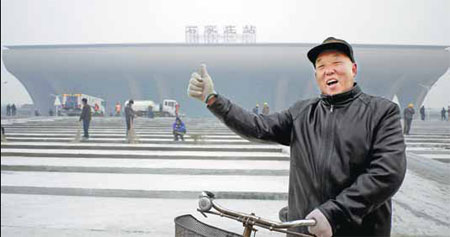Railway cities staying on track
Updated: 2013-07-16 07:15
By Zheng Jinran (China Daily)
|
||||||||
|
Shijiazhuang Railway Station at peak time as students start their summer vacations. Zhu Xudong / Xinhua |
|
Above: A resident shows his appreciation of Shijiazhuang's new railway station. Below: A visitor takes a photo of a sculpture that stands in front of the city's old railway station. Photos Provided to China Daily |
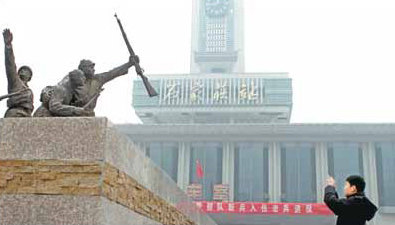
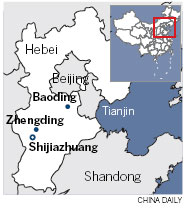
The original beneficiaries of China's railway system are still reaping the rewards and hoping for continued success in the future, reports Zheng Jinran in Shijiazhuang.
In 1902, when the Empress Dowager Cixi of the Qing Dynasty (1644-1911) returned to Beijing after her panicked flight from the capital in the face of an invasion by the allied armies of eight countries, she decided to emphasize her return to power by riding on China's new railway system.
Cixi, who ruled for almost five decades, started her trip at Zhengding in Hebei province, which at that time was a bustling metropolis, equal to Beijing in economic, cultural and military importance.
Meanwhile, just 15 kilometers away, in Shijiazhuang, a village so small that the empress is unlikely to have even known of its existence, the 200 households were thrilled but apprehensive about the long iron rails that extended far into the distance and the noisy steam engines that belched smoke as they traveled back and forth.
Few of the residents could have imagined that a second railway would arrive five years later, when the line connecting the village with Taiyuan in Shanxi province opened in 1907. Equally unimaginable was the notion that the hamlet, named after the locally renowned Shi family, would overtake its stronger neighbor to become more prosperous and populous.
The railway made Shijiazhuang. The village's first factory, which made and repaired railway carriages, opened in 1905. Inns were established to cater for the rising number of rail passengers who thronged the sidewalks close to the station. By the time the Qing Dynasty fell six years later, the village had been transformed into a booming business center.
That was just the start, though. During the course of the 20th century, the local economy boomed and the population mushroomed spectacularly; it has more than quadrupled in the past 30 years.
By 2012, Shijiazhuang, now the capital of Hebei, the province with sixth-strongest GDP in China that year, had a population of more than 10 million. By contrast, Zhengding became a county under the administration of Shijiazhuang, which is known as "a city that was pulled by the train".
Shijiazhuang was not the only urban center to benefit from the advent of rail transport. Many other cities rose as the network attracted businesses and workers. Zhengzhou, the capital and largest city in Henan province; Zhuzhou a strong economic center in central China's Hunan province; and Shenzhen in Guangdong province, all enjoyed unprecedented rapid growth, fueled by the industries that evolved from the railways.
However, growth also resulted in problems, mainly those associated with urban planning, as floods of workers migrated to the cities in search of work.
Home from home
The railway still plays an important role in the lives of Shijiazhuang's residents. On Friday afternoon, Zhang Chao called his wife to tell her that he would be joining the family for dinner that evening. After taking the bullet train from Beijing, the 26-year-old arrived at the family home at around 7:30 pm, seeing his wife and parents for the first time in five days.
Zhang's routine hasn't changed for the past two years; he leaves Shijiazhuang every Monday morning to travel to his job in Beijing and returns every Friday.
"It once occurred to me to buy an apartment in Beijing to save time traveling back and forth," said Zhang, who works as a legal consultant for the Beijing Railway Bureau. "But I can't afford the high property prices in Beijing - the average price was more than 17,000 yuan ($2,800) per square meter in June."
Zhang began his nomadic lifestyle soon after he started his job. "The journey only takes 70 minutes on the high-speed train, and at most two hours for the entire one-way trip including the bus from the railway station to my residential community. But sometimes Beijing residents spend just as long trapped in their cars in traffic jams, so it's quite acceptable."
His case is by no means unique, as many young people choose to remain in their hometowns because of the lower property prices, but work in Beijing because the wages are higher and there is a greater number of opportunities.
Businesspeople also benefit. "It's a great time for local companies to do business in Beijing," said Li Kang a manager at Jingkang Co, a chemical company that sells commodities, mainly in Shijiazhuang and Xingtai city, where Li lives.
His company purchases bulk goods, such as soda ash, in the Inner Mongolia autonomous region and the northwestern province of Qinghai and transports them by rail via Beijing to clients in Hebei. When a high-speed rail link between the source areas and Beijing opened in 2012, the journey time for the raw materials was cut to seven days from 20, allowing Li to increase the frequency of his purchases of raw materials.
"We plan to explore the huge market in Beijing, because it's easy and convenient to transport the materials to customers there. Some potential clients have realized that and have approached us with orders," said the 28-year-old, whose company has an average annual trade volume of 20 million yuan per annum. "We plan to cooperate more fully with companies in Beijing," he added.
Like many decision-makers in local companies, Li regards Beijing as a gold mine and is making moves to tap the huge potential market. The speed of travel between the Chinese capital and Shijiazhuang is a boon for business cooperation, especially for Shijiazhuang, because of the obvious advantages enjoyed by the capital in terms of talent, financing and technology, among other factors.
In 2012, Beijing invested 219 billion yuan in Hebei, about 43 percent of the provincial total, according to government statistics. Meanwhile, on May 22, Beijing and Hebei signed a contract listing the main areas of cooperation in the next two years. They include the local economy, environmental protection, and the transfer of certain industries from the capital to the province - the growth of the high-speed rail network is a priority item on the agenda.
Resource imbalance
The relationship is not without friction, though. While Shijiazhuang and other cities in Hebei understand the strategic importance of supporting the capital, by providing water and energy for example, there have been complaints that Beijing is draining the pool of local talent and other resources.
"In the early stage of regional cooperation, there exists an imbalance in the flow of resources, not just in this area, but also in the Yangtze River Delta and other areas. It's a phenomenon that's also been seen in other countries and is a general trend during development," said Xing Tianhe, deputy chief planner at Hebei's department of housing and urban-rural development.
The cities in these economic clusters need to pursue different routes of development, utilizing a variety of resources to avoid unnecessary competition, said Xing, who noted that the financial gap separating Shanghai, and the cities of Hangzhou and Nanjing is not as wide as that separating Beijing, Tianjin and Shijiazhuang.
"Shijiazhuang should take advantage of the shared resources, but it must pursue its own path and then it will be able catch up with the two municipalities," said Xing.
Throughout the development period, the railway acted as a lifeline and in several transport hubs, the main rail routes pass through the downtown areas. In Shijiazhuang, large open markets have grown around the railway station, raising the numbers of local passengers, especially during rush hours.
The city government has ploughed money into the transport infrastructure, building overpasses and bridges to connect districts separated by the rail line.
"The cities where expansion was fueled by the railway share similar space restrictions on urban planning," said Xing. His preferred solution is the one adopted by Shijiazhuang; relocating the railway stations away from the downtown areas.
Although the railways brought modern industries to the new cities, they also brought pollution.
Initially the pollution was caused by the railway, especially during the era of steam engines, in the form of noise, waste water, litter and smoke. It became a huge problem for cities on the major routes.
In addition, the industries were highly polluting. In Shijiazhuang, iron, steel and textiles were the pillars of the local economy for many years.
In the past five years, the local government has produced a raft of policies that will optimize the industry structure while protecting the environment at the same time.
"The heavy smog that covered the city for months was not directly connected with the railway, but the city's economy expanded through industries drawn by and related to the railway," said Liang Yong, vice-president of the Hebei Institute of Tourism Planning and Development. He pointed out that the city of Tangshan, which was spurred by the development of the railway, has a serious environmental problem. "These cities were all influenced by the railway to a certain degree."
'Immigrant cities'
In most cases, the cities driven by the railways have always played host to large numbers of workers from other parts of China and although that can promote multiculturalism, local traditions can become subsumed.
"Some of these 'cities pulled by trains', also known as immigrant cities, did not have a deeply rooted traditional culture, which meant the residents didn't share a common cultural consciousness. That can be detrimental to urban development because there are no defined local characteristics," said Liang.
He gave Shijiazhuang as an example: In less than a century it has grown from a village of just 200 households to a mega-city with a population of millions, 90 percent of whom come from outside. When the authorities decided to erect statues in public places, they discovered that the figures depicted were generic and had little or no connection with the city's history. Moreover, Shijiazhuang's modern buildings are unremarkable.
"If you took away the local signposts, Shijiazhuang would look no different to any other modern city, in other words, it lost its traditions during development," said Liang.
Zhang Chao lamented the fact that he is unable to offer special hometown snacks to his friends in Beijing. "The lack of special snacks and cuisine demonstrates the lack of local tradition," he said.
Liang echoed that view, noting that the city has few tourist sites of historic interest, indicating that the traditional culture has not been protected.
"Many cities that developed because of the railway have the same problems. They have not combined the diverse cultures brought by the waves of immigrants during the period of rapid economic growth, and as such, the cities risk losing their traditions," said Xing.
"Shijiazhuang witnessed rapid development in the last century thanks to the spread of the railway, but the railway also brought challenges, such as large numbers of immigrants. However, as a transport hub it can still benefit from the rail system if it handles those challenges well."
Contact the writer at zhengjinran@chinadaily.com.cn
(China Daily USA 07/16/2013 page7)

 Obama urges restraint amid protests
Obama urges restraint amid protests
 Putin wants Snowden to go, but asylum not ruled out
Putin wants Snowden to go, but asylum not ruled out
 Apple to probe death of Chinese using charging iPhone
Apple to probe death of Chinese using charging iPhone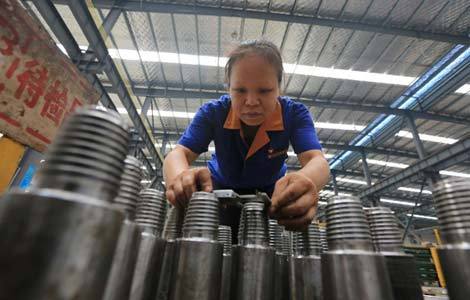
 Investment falters as industrial activity flags
Investment falters as industrial activity flags
 Rape victim's mother wins appeal
Rape victim's mother wins appeal
 Reproduction of 'Sunflowers' displayed in HK
Reproduction of 'Sunflowers' displayed in HK
 Land Rover enthusiasts tour the world
Land Rover enthusiasts tour the world
 US star sprinter fails drug test
US star sprinter fails drug test
Most Viewed
Editor's Picks

|

|
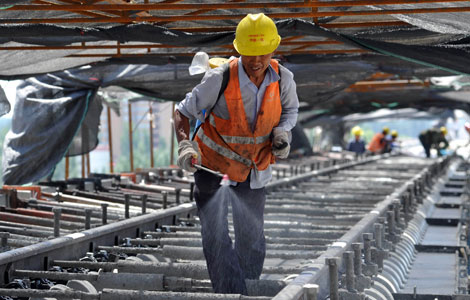
|

|

|

|
Today's Top News
China calls for new talks on Iran nuclear issue
Global warming may largely raises sea level
Putin wants Snowden to go, asylum not ruled out
Top foreign study destinations for Chinese
Trailblazer reaches out to inmates on death row
Air crash payouts could differ
Cabinet promises more funds for smaller firms
Capital prison tests therapy on inmates
US Weekly

|

|

